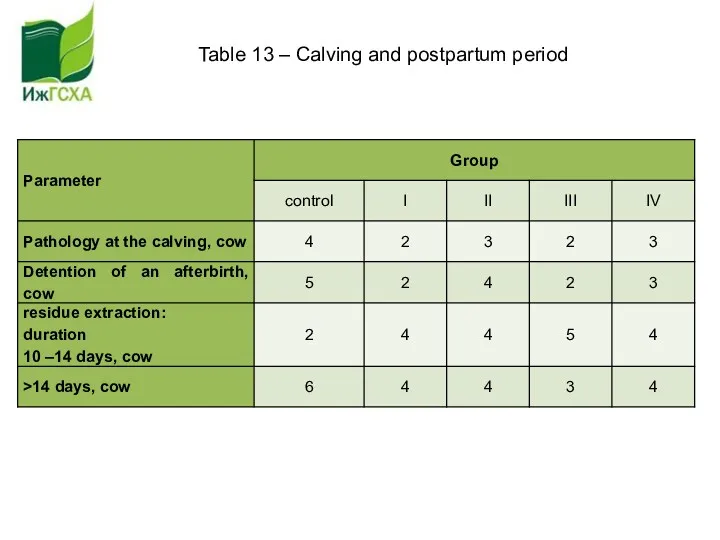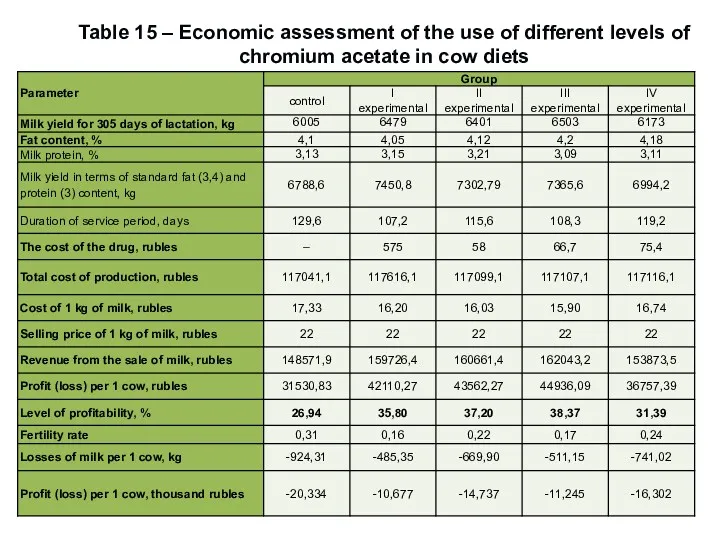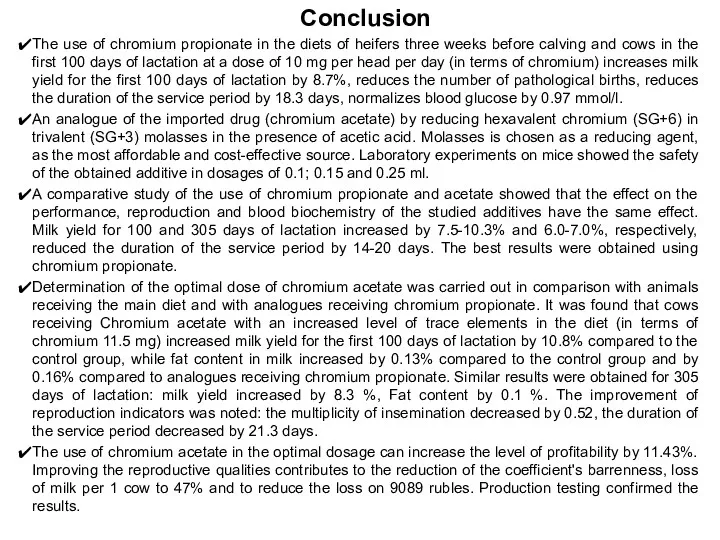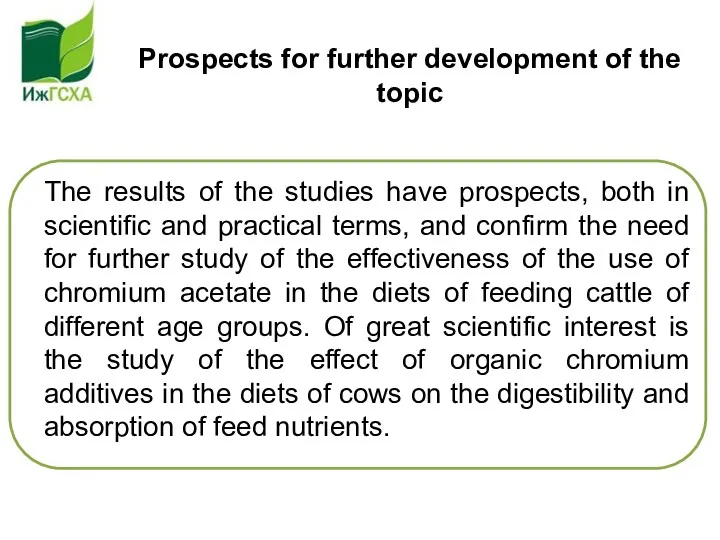Indicators of productivity of cows of the black-pestro breed during use in rations organic chrome презентация
Содержание
- 2. PURPOSE comprehensive study of cow productivity indicators against the background of the use of chromium-containing additives
- 3. Tasks: to study the effect of the use of chromium propionate in the diets of cows
- 4. Experimental studies were carried out on the basis of "Educational farm July Izhevsk state agricultural Academy"
- 5. Table 1 - Milk productivity and quality characteristics of milk of cows for the first 100
- 6. Table 2 - Dairy productivity of cows for 305 days of the finished lactation
- 7. Table 3 – Calving and postpartum period
- 8. Table 4 – reproductive performance
- 9. Chromium acetate→ the increase of insulin activity → increased glucose metabolism → increased energy use of
- 10. Laboratory research
- 11. Table 5 - Milk productivity and quality characteristics of milk of cows for the first 100
- 12. Таблица 6 – Молочная продуктивность коров за 305 дней лактации
- 13. Table 7 – Biochemical indicators of blood of cows
- 14. Table 8 – Calving and postpartum period
- 15. Table 9 – Reproductive performance
- 16. Table 10 - Milk productivity and quality characteristics of milk of cows for the first 100
- 17. Table 11 - Dairy productivity of cows for 305 days of the finished lactation
- 18. Table 12 – Biochemical indicators of blood of cows Note : *Р≥0,95
- 19. Table 13 – Calving and postpartum period
- 20. Table 14 – Reproductive performance
- 21. Table 15 – Economic assessment of the use of different levels of chromium acetate in cow
- 22. Conclusion The use of chromium propionate in the diets of heifers three weeks before calving and
- 23. To increase milk productivity, improve the reproductive qualities of cows, as well as improve the economic
- 24. The results of the studies have prospects, both in scientific and practical terms, and confirm the
- 26. Скачать презентацию























 Genetically modification organism (GMO)
Genetically modification organism (GMO) Мир рептилий. Первые пресмыкающиеся (рептилии)
Мир рептилий. Первые пресмыкающиеся (рептилии) Тренажёр В мире животных
Тренажёр В мире животных Старение человека и возможность бессмертия
Старение человека и возможность бессмертия Хемосинтез. Хемосинтезирующие организмы
Хемосинтез. Хемосинтезирующие организмы Взаимодействия организмов в экосистемах
Взаимодействия организмов в экосистемах Презентация по теме Антропогенез часть 1
Презентация по теме Антропогенез часть 1 Основные методы селекции и биотехнологии
Основные методы селекции и биотехнологии Органы чувств. Зрение и слух
Органы чувств. Зрение и слух Синапс. Классификация синапсов
Синапс. Классификация синапсов Тип моллюски
Тип моллюски Определение содержания аскорбиновой кислоты (витамина С) в различных сортах яблок
Определение содержания аскорбиновой кислоты (витамина С) в различных сортах яблок Mutation
Mutation Биополимеры. Нуклеиновые кислоты. АТФ
Биополимеры. Нуклеиновые кислоты. АТФ сон и сновидения
сон и сновидения Влияние засоления почвы на процессы роста растений
Влияние засоления почвы на процессы роста растений Отряд хищные
Отряд хищные Соматическая и вегетативная НС
Соматическая и вегетативная НС Биологическая обработка органических отходов , их характеристика и принципы обработки
Биологическая обработка органических отходов , их характеристика и принципы обработки Зимующие птицы
Зимующие птицы Задачи и методы генетики. Подготовка к ЕГЭ
Задачи и методы генетики. Подготовка к ЕГЭ Густота лесных культур
Густота лесных культур Работы Никитина Никиты уч-ся 7 класса
Работы Никитина Никиты уч-ся 7 класса Царство Грибы. Лишайники. Общая характеристика грибов
Царство Грибы. Лишайники. Общая характеристика грибов урок биологии в 8 классе Живая крепость
урок биологии в 8 классе Живая крепость презентация на тему Плоды
презентация на тему Плоды Кругообіг азоту в природі
Кругообіг азоту в природі Конкурс внутреннего и внешнего озеленения образовательных организаций
Конкурс внутреннего и внешнего озеленения образовательных организаций